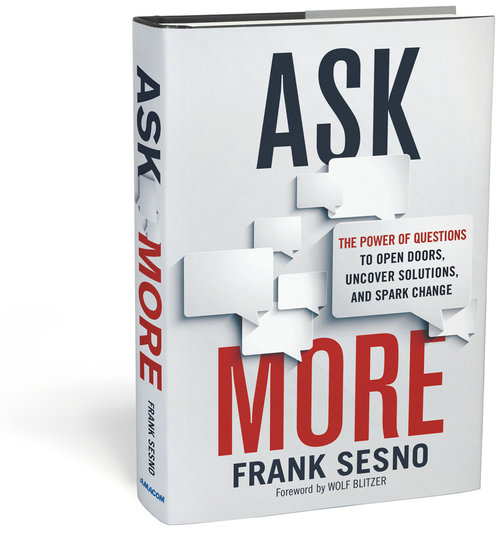Book Recommendation: Ask More
If you could think of one change to make in your communication habits that would make you more influential, more interesting, and more well-liked, what would it be? The answer, according to Frank Sesno—and one which I strongly endorse—is to ask more questions. In his book, Ask More: The Power of Questions to Open Doors, Uncover Solutions and Spark Change, Sesno, a former CNN anchor, explains why questions are so powerful and how to ask them.
In this review, I will ask and answer four questions:
- Why should you ask more questions?
- Why read this book?
- What are some of the main lessons?
- How should you read the book?
Why ask more questions?
You probably don’t ask enough questions—so what? The big-picture answer, filtered through the lens of lean communication, is that you are producing less value and more waste than you should. Value is defined by the listener, and if you don’t know your listeners as well as you should, how can you express your points in ways that are most likely to resonate with them? Asking more questions helps you zero in on exactly what’s important to the other person. But even better, asking questions engages the other person so that together you both create more value and more memorable communication. I love this quote from the book: “People forget what they heard, but they remember almost everything they say.”
Why read this book?
There are many good books on questioning, written from the perspective of sales, psychology, management[1], etc. but this is the first one (that I’ve read, at least) by a journalist, who by definition makes his living through the quality of his questions. Besides the credibility it adds to the book, Sesno’s professional expertise adds two other assets that make Ask More worth reading. First, he knows how to find other credible sources, so he is not just relying on what has worked for him, as so many experts do, and this brings a breadth and diversity of different situations and applications where questioning is helpful. of questioning applications. Second, he knows how to tell stories lucidly and concisely, so the book makes for pleasant and engaging reading.
What are some of the main lessons?
The book is organized into chapters that explain how to ask questions for different purposes, from solving problems to inspiring others, to sparking creative thinking, to building rapport. But regardless of your purpose in asking questions, some general principles come through. Probably the most important is that you should have a purpose and a plan for your questions. Your plan will help ensure that you don’t miss anything important, and your purpose will keep you on track when the person you’re interviewing inevitably throws you off your plan, whether accidentally or on purpose. Second is the importance of knowing how to listen to the answers and what to listen for—especially what is not being said. Third, by learning the basic structure of each specific questioning application, you can apply a reasonably repeatable process that will save you time and ensure you don’t miss anything.
How should you read the book?
If there is one improvement opportunity I would suggest for this book, it would be to go a bit lighter on the stories and heavier on the “how-to”. For example, in the chapter on empathetic questioning, as he introduces a man who got John Hinckley to open up through questions, do we really need to know the path of each of the six bullets John Hinckley fired? That’s why I would suggest that you begin reading the book at page 211, which begins the “Question Guide” section, where the basics of each major questioning task are laid out. Then, you can go back through the book and read the sections that you find most useful, and having the layout of each section in mind will make it easier to tease out the lessons from the stories and extraneous detail.
Despite that last quibble, Ask More is an important and worthwhile book. We can all benefit from improving the quantity and quality of the questions we ask, and I personally resolve to improve on that this year. So, let me end with one more question:
What are you waiting for?
[1] A few good examples: SPIN Selling and Question Based Selling for Sales; Leading with Questions, for leadership;
Humble Inquiry, for psychology.



